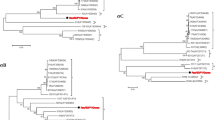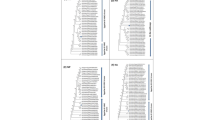Abstract
The use of adeno-associated viruses (AAVs) as vectors for gene delivery is well established; however, genomic information about avian adeno-associated virus (AAAV) and its use are still limited. In this study, an AAAV strain, YZ-1, was isolated from healthy chickens in China, and the complete genome was sequenced. The genomic DNA of YZ-1 is 4,684 nucleotides long, including two ORFs encoding the nonstructural proteins (Rep) and the structural proteins (Cap), and an inverted terminal repeat (ITR) forming a typical T-shaped palindromic structure at each end. YZ-1 was 95.0 and 92.2% identical to the other two reported AAAV strains, DA-1 and VR-865, respectively, at the nucleotide sequence level. In comparison to VR-865, frameshift mutations or deletions in the N-terminal region of the Rep78 protein or VP2 protein were observed in YZ-1 and DA-1. Phylogenetic analysis revealed that YZ-1, DA-1 and VR-865 could be classified into the avian group of the AAV family. This group and other AAVs of mammalian origin displayed almost equal divergence from pathogenic waterfowl parvoviruses, revealing that AAAV has no direct evolutionary relationship to them. This study therefore provides new genomic information about AAAV.






Similar content being viewed by others
References
Atchison RW, Casto BC, Hammon WM (1965) Adenovirus-associated defective virus particles. Science 147:754–756
Bantel-Schall U, Hausen HZ (1984) Characterization of the DNA of a defective human parvovirus isolated from a genital site. Virology 134:52–63
Bauer HJ, Monreal G (1986) Herpesviruses provide helper functions for avian adeno-associated parvovirus. J Gen Virol 67:181–185
Berns KI, Adler S (1972) Separation of two types of adeno-associated virus particles containing complementary polynucleotide chains. J Virol 9:394–396
Bossis I, Chiorini JA (2003) Cloning of an avian adeno-assocoated virus (AAAV) and generation of recombinant AAAV particles. J Virol 77:6799–6810
Buller RM, Janik E, Sebring ED, Rose JA (1981) Herpes simplex virus types 1 and 2 completely help adenovirus-associated virus replication. J Virol 40:241–247
Carter BJ (2004) Adeno-associated virus and the development of adeno-associated virus vectors: a historical perspective. Mol Ther 10:981–989
Chiorini JA, Kim F, Yang L, Kotin RM (1999) Cloning and characterization of adeno-associated virus type 5. J Virol 73:1309–1319
Estevez C, Villegas P (2004) Sequence analysis, viral rescue from infectious clones and generation of recombinant virions of the avian adeno-associated virus. Virus Res 105:195–208
Fauquet CM, Mayo MA, Maniloff J, Desselberger U, Ball LA (2004) Virus taxonomy, 8th Report of the ICTV. Elsevier/Academic Press, London
Gerry HW, Kelly TJ, Berns KI (1973) Arrangement of nucleotide sequences in adeno-associated virus DNA. J Mol Biol 79:207–212
Hess M, Paul G, Kling S, Monreal G (1995) Molecular characterization of two strains of the avian adeno-associated virus (AAAV). Arch Virol 140:591–598
Im DS, Muzyczka N (1992) Partial purification of adeno-associated virus Rep78, Rep52, and Rep40 and their biochemical characterization. J Virol 66:1119–1128
Lusby E, Bohenzky R, Berns KI (1981) Inverted terminal repetition in adeno-associated virus DNA: independence of the orientation at either end of the genome. J Virol 37:1083–1086
Mayor HD, Torikai K, Melnick JL, Mandel M (1969) Plus and minus single-stranded DNA separately encapsidated in adeno-associated satellite virions. Science 166:1280–1282
Muralidhar S, Becerra SP, Rose JA (1994) Site-directed mutagenesis of adeno-associated virus type 2 structural protein initiation codons: effects on regulation of synthesis and biological activity. J Virol 68:170–176
Nahreini P, Larsen SH, Srivastava A (1992) Cloning and integration of DNA fragments in human cells via the inverted terminal repeats of the adeno-associated virus 2 genome. Gene 119:265–272
Samulski RJ, Berns KI, Tan M, Muzyczka N (1982) Cloning of adeno-associated virus into pBR322: rescue of intact virus from the recombinant plasmid in human cells. Proc Natl Acad Sci 79:2077–2081
Samulski RJ, Srivastava A, Berns KI (1983) Rescue of adeno-associated virus from recombinant plasmids: gene correction within the terminal repeats of AAV. Cell 33:135–143
Schmidt M, Katano H, Bossis I, Chiorini JA (2004) Cloning and characterization of a bovine adeno-associated virus. J Virol 78:6509–6516
Snyder RO, Im DS, Muzyczka N (1990) Evidence for covalent attachment of the adeno-associated virus (AAV) Rep protein to the ends of the AAV genome. J Virol 64:6204–6213
Suroshy RT, Urabe M, Godwin SG, Mcquiston SA, Kurtzman GJ, Ozawa K, Natsoulis G (1997) Adeno-associated virus rep proteins target DNA sequences to a unique locus in the human genome. J Virol 71:7951–7959
Trempe JP, Carter BJ (1988) Alternate mRNA Splicing is required for synthesis of adeno-associated virus VP1 Protein. J Virol 62:3356–3363
Wang XS, Ponnazhagan S, Srivastava A (1996) Rescue and replication of adeno-associated virus type 2 as well as vector DNA sequences from recombinant plasmids containing deletions in the viral inverted terminal repeats: selective encapsidation of viral genomes in progeny virions. J Virol 70:1668–1677
Warrington KH, Gorbatyuk OS, Harrison JK, Opie SR, Zolotukhin S, Muzyczka N (2004) Adeno-associated virus type 2 VP2 capsid protein is nonessential and can tolerate large peptide insertions at its N terminus. J Virol 78:6595–6609
Xie Q, Bu WS, Bhatia S, Hare J, Somasundaram T, Azzi A, Chapman MS (2002) The atomic structure of adeno-associated virus (AAV-2), a vector for human gene therapy. Proc Natl Acad Sci 99:10405–10410
Yates VJ, el-Mishad AM, McCormick KJ, Trentin JJ (1973) Isolation and characterization of an avian adenovirus-associated virus. Infec Immun 7:973–980
Yates VJ, Fry RYO, el-Mishad AM (1976) The presence of avian adenoviruses and adeno-associated viruses in healthy chickens. Avian Dis 20:146–152
Yates VJ, Rhee YO (1976) Procedure for the isolation of avian adenovirus and avian adeno-associated viruses. Avian Dis 21:315–318
Yoon-Robarts M, Linden RM (2003) Identification of active site residues of the adeno-associated virus type 2 Rep endonuclease. J Biol Chem 279:4912–7918
Author information
Authors and Affiliations
Corresponding author
Rights and permissions
About this article
Cite this article
Wang, J., Zhu, L., Zhu, J. et al. Molecular characterization and phylogenetic analysis of an avian adeno-associated virus originating from a chicken in China. Arch Virol 156, 71–77 (2011). https://doi.org/10.1007/s00705-010-0822-x
Received:
Accepted:
Published:
Issue Date:
DOI: https://doi.org/10.1007/s00705-010-0822-x




